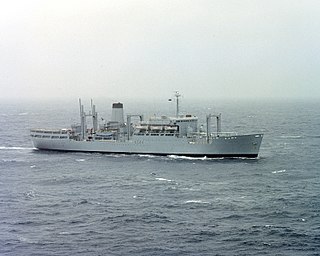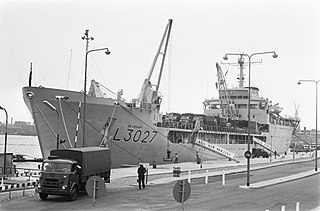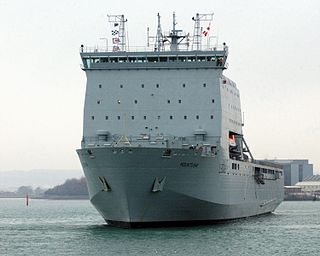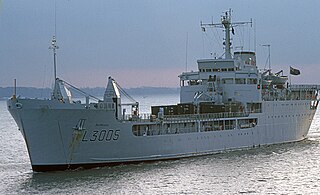
The Royal Fleet Auxiliary (RFA) is a naval auxiliary fleet owned by the UK's Ministry of Defence. It is a component of His Majesty's Naval Service and provides logistical and operational support to the Royal Navy and Royal Marines. The RFA ensures the Royal Navy is supplied and supported by providing fuel and stores through replenishment at sea, transporting Royal Marines and British Army personnel, providing medical care and transporting equipment and essentials around the world. In addition the RFA acts independently providing humanitarian aid, counter piracy and counter narcotic patrols together with assisting the Royal Navy in preventing conflict and securing international trade. They are a uniformed civilian branch of the Royal Navy staffed by British merchant sailors. The RFA is one of five RN fighting arms.

RFA Sir Bedivere (L3004) was a Landing Ship Logistic of the Round Table class. She saw service in the Falklands War, the Persian Gulf and Sierra Leone. In 2009, she was commissioned into the Brazilian Navy and renamed NDCC Almirante Saboia (G-25), where she saw service in Haiti.

RFA Sir Percivale (L3036) was a Round Table class landing ship logistics (LSL) vessel belonging to the Royal Fleet Auxiliary of the United Kingdom.

TV Sir Tristram (L3505) formerly RFA Sir Tristram, is a Round Table-class landing ship logistics that was converted to a Special Forces Training Vessel in 2008. She was launched in 1966, and accepted into British Army service in 1967. As with others of her class, she was transferred to the Royal Fleet Auxiliary in 1970, and was crewed by British officers and Hong Kong Chinese sailors. The ship saw service in the Falklands War of 1982, and was badly damaged at Fitzroy on 8 June.
This is a list of the naval forces from the United Kingdom that took part in the Falklands War, often referred to as "the Task Force" in the context of the war. For a list of naval forces from Argentina, see Argentine naval forces in the Falklands War.

RFA Diligence was a forward repair ship of the Royal Fleet Auxiliary. Launched in 1981 as a support ship for North Sea oil rigs, she was chartered by the British government to support naval activities during the 1982 Falklands War and was later bought outright as a fleet maintenance vessel. She gave assistance to the damaged USS Tripoli and Princeton in the 1991 Gulf War, and to Sri Lanka after the 2005 tsunami. She typically had deployments of 5-8 years in support of the Trafalgar-class submarine on duty east of Suez, with a secondary role as a mothership for British and US minesweepers in the Persian Gulf. Until 2016 Diligence was set to go out of service in 2020. However in August 2016, the UK Ministry of Defence placed an advert for the sale of RFA Diligence. As of 2016 the option for the delivery of future operational maintenance and repair capability for the RFA remained under consideration. However, the 2021 British defence white paper made no specific mention of the need for this capability. In April 2023, it was revealed that the ship was to be scrapped after no suitable buyers materialised, & she was moved out of 3 Basin across to Fareham Trots to await her final journey to the scrapyard.

RFA Olna (A123) was the third and final of the three Ol-class "fast fleet tanker" of the Royal Fleet Auxiliary. Olna saw service in the Falklands War.

RFA Stromness (A344) was a fleet stores ship which served the Royal Fleet Auxiliary until sold to the U.S. Navy's Military Sealift Command in 1983. While in the service of British forces, it saw service in the Falklands War. After the sale to the United States, it was renamed USNS Saturn (T-AFS-10) and acted as a combat stores ship until it was deactivated in 2009; it was able to supply two other ships at once. In 2010, it was sunk in an exercise by the U.S. Carrier Strike Group Two off the coast of North Carolina.

HMAS Choules (L100) is a Bay-class landing ship that served with the Royal Fleet Auxiliary (RFA) from 2006 to 2011, before being purchased by the Royal Australian Navy (RAN). The vessel was built as RFA Largs Bay by Swan Hunter in Wallsend, Tyne and Wear. She was named after Largs Bay in Ayrshire, Scotland, and entered service in November 2006. During her career with the RFA, Largs Bay served as the British ship assigned to patrol the Falkland Islands in 2008, and delivered relief supplies following the 2010 Haiti earthquake.

RFA Sir Geraint (L3027) was a Landing Ship Logistic of the Round Table class. She saw service in the Falklands War and Sierra Leone.

The Round Table class, also known as the Sir Lancelot class, was a British ship class designed for amphibious warfare missions in support of the main amphibious warfare ships. They were designated landing ship logistics (LSL). The class was almost certainly so named on account of the phonetic similarity between the abbreviation LSL and Lance-'S'-Lot.

The Bay class is a ship class of four dock landing ships built for the British Royal Fleet Auxiliary (RFA) during the 2000s. They are based on the Dutch-Spanish Royal Schelde Enforcer design, and replaced the Round Table-class logistics ships. Two ships each were ordered from Swan Hunter and BAE Systems Naval Ships. Construction work started in 2002, but saw major delays and cost overruns, particularly at Swan Hunter's shipyard. In mid-2006, Swan Hunter was stripped of work, and the incomplete second ship was towed to BAE's shipyard for completion. All four ships, Largs Bay, Lyme Bay, Mounts Bay, and Cardigan Bay had entered service by 2007.

Standing Royal Navy deployments is a list of operations and commitments undertaken by the United Kingdom's Royal Navy on a worldwide basis. The following list details these commitments and deployments sorted by region and in alphabetical order. Routine deployments made by the Navy's nuclear-powered submarines and their location of operations is classified.

His Majesty's Naval Service is the United Kingdom's naval warfare and maritime service. It consists of the Royal Navy, Royal Marines, Royal Fleet Auxiliary, Royal Naval Reserve, Royal Marines Reserve and Naval Careers Service. The Naval Service as a whole falls under the command of the Navy Board, which is headed by the First Sea Lord. This position is currently held by Admiral Sir Ben Key. The Defence Council delegates administration of the Naval Service to the Admiralty Board, chaired by the Secretary of State for Defence.

847 Naval Air Squadron is a squadron of the Royal Navy Fleet Air Arm. It operates AgustaWestland Wildcat AH.1 helicopters and provides armed reconnaissance and light transport support to 3 Commando Brigade Royal Marines. Along with 845 and 846 naval air squadrons, it forms part of the Commando Helicopter Force. The squadron was re-formed from 3 Commando Brigade Air Squadron on 1 September 1995.

RFA Wave Ruler is a Wave-class fast fleet tanker of the Royal Fleet Auxiliary (RFA) of the United Kingdom tasked with providing fuel, food, fresh water, ammunition and other supplies to Royal Navy vessels around the world.

The 1982 British military campaign to recapture the Falkland Islands depended on complex logistical arrangements. The logistical difficulties of operating 7,000 nautical miles from home were formidable. The Argentine invasion of the Falkland Islands came at a time when the Royal Navy was experiencing a reduction in its amphibious capability, but it still possessed the aircraft carriers HMS Hermes and Invincible, the landing platform dock (LPD) ships HMS Fearless and Intrepid, and six landing ship logistics (LSL) ships. To provide the necessary logistic support, the Royal Navy's ships were augmented by ships taken up from trade (STUFT).
The Battle of San Carlos was a battle between aircraft and ships that lasted from 21 to 25 May 1982 during the British landings on the shores of San Carlos Water in the 1982 Falklands War. Low-flying land-based Argentine jet aircraft made repeated attacks on ships of the British Task Force.
In 1989 the Royal Navy was under the direction of the Navy Department in the UK Ministry of Defence. It had two main commands, CINCFLEET and Naval Home Command.

















